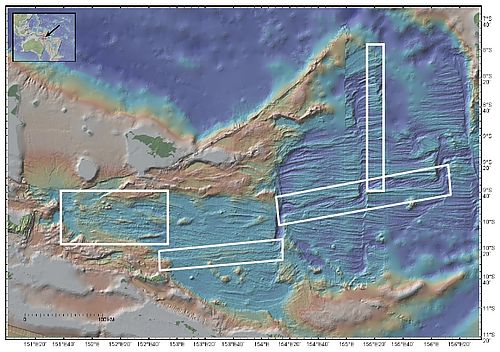Magma genesis, tectonics and hydrothermalism along the propagating spreading axis in the Woodlark Basin
Continental rifting and break-up have changed the face of our planet for billions of years. Through the incorporation of continental fragments into the oceanic crust and mantle, break-up has also strongly influenced global geochemical cycles. Deep-reaching fractures formed during break-up allow large-scale circulation of water within the continental material, possibly leading to the formation of (precious-) metal deposits.
Present-day regions of continental break-up are generally covered by thick sediment layers, only the Woodlark Basin, east of Papua New Guinea (Fig. 1), comprises sediments that are thin enough to allow sampling and observations. In this project we use ship-based and AUV technology to study the links between tectonics, magmatism and hydrothermalism during break-up by sampling and observing the developing spreading axis and continental rift.
Detailed bathymetric, side-scan and geomagnetic maps have been published by Martinez et al. (2001). The position of the spreading axis and its evolution through time can be reconstructed very precisely using these maps and their interpretation. Geophysical results indicate a distinct, approx. 1-2 km wide transition zone between rifting of the crust and the initiation of oceanic spreading. Taylor et al. (1995) have shown that the propagation of spreading into the continental crust is characterized by a spontaneous formation of new spreading segments.
The major goals of our proposed project are:
1) To reconstruct the chemical zonation of the mantle produced by oceanic opening.
We carried out detailed sampling and chemical analyses of magmas along and perpendicular to the spreading axis, as their chemistry provides a “window” into the mantle. Observed mantle heterogeneities in the sources of oceanic magmas are often proposed to be the result of a mixture of continental crust and lithospheric mantle with the asthenosphere during the opening of an ocean basin. This hypothesis can be tested by investigating the distribution of continental material during the opening of the basin. The chemistry of the spreading axis magmas provides information about the contamination of mantle material by continental crust at the propagating spreading tip.
2) Sample and investigate how continental fragments become entrained in oceanic crust.
Studies at old passive continental margins have shown that during the opening of an ocean basin large blocks of continental lithosphere become incorporated into the ocean crust. However, up to present we have no information on how the process of fragmentation and incorporation of continental crust occurs.
3) Study the influence of crustal contamination on the formation of seafloor hydrothermal systems.
Detailed mapping and plume hunting (using the AUV) was carried out in order to locate and sample hydrothermal vents in calc-alkaline crust. Continental rifting gives favourable conditions for the formation of large ore deposits in enriched wall rocks due to the enhanced heat flow in the crust. Based on the low sediment cover of the Woodlark spreading axis this region is the best place worldwide to investigate the processes of ore formation during continental break-up.
Instruments used include the AUV "Abyss", a deep-towed side-scan sonar, the GEOMAR video-guided TV-grab, a wax corer and dredges.
Weekly reports from the cruise are available. The cruise started on October 27th 2009 from Townsville, Australia and ended in Auckland, New Zealand on December 06th 2009.
principle investigator: Prof. Colin Devey
scientific employees: Dipl.-Geol. Julia Mahlke, Dipl.-Geol. Romed Speckbacher
funding period: 2009-2011
funding source: BMBF
co-operation: Helmholtz-Zentrum für Ozeanforschung Kiel | GEOMAR (Prof. J. Behrmann, Prof. K. Hoernle, Dr. S. Petersen, Dr. K. Lackschewitz, Dr. I. Klaucke, Dr. P. van den Bogaard), Universität Bonn (Dr. T. Nagel), SOEST at the University of Hawaii at Manoa, USA (Dr. B. Taylor, Dr. F. Martinez), University of Alabama, USA (Dr. A. Goodliffe), National Institute of Advanced Industrial Science and Technology (AIST) Tsukuba, Japan (Dr. K. Nakamura), University of Ottawa, Kanada (Dr. M.D. Hannington), Nautilus Minerals



